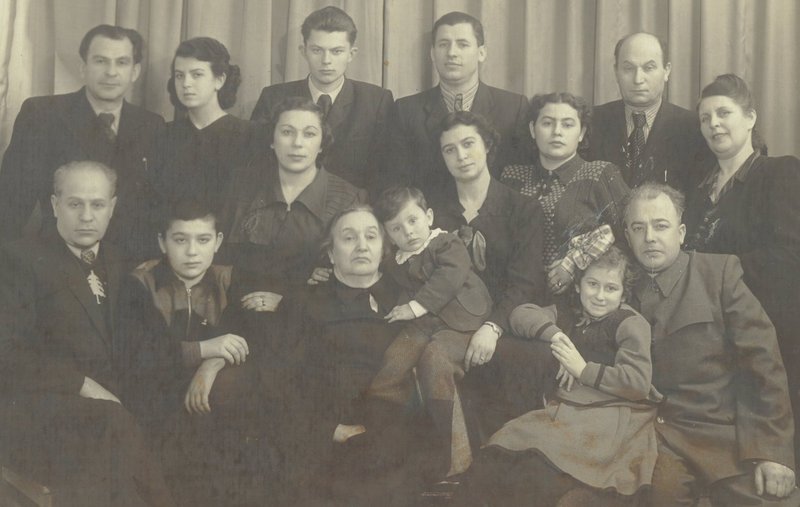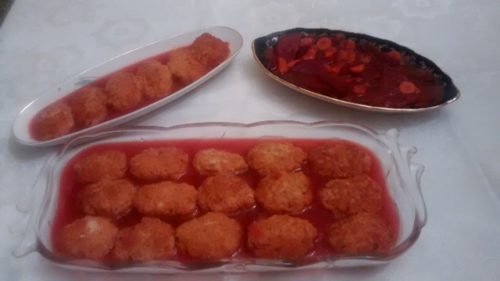A treasure of memories co-written by Lida Magidenko and her son, Alex Strashny.
Strudel
While going through my papers recently, I found a few Jewish recipes from Mom and from Babushka Roza. Babushka Roza was my only grandparent to survive World War II. “Babushka” means “Grandma” in Russian.
While her real name was Fruma-Reyzl Shuster, at the time, I only knew her by her Russian name “Roza”.

One of the recipes that I found is for this strudel. I wrote it down as Babushka Roza dictated it to me, ages ago. She and I did not share a written language in common. Babushka Roza knew both Yiddish and Russian, and while she was literate in Yiddish, I am not sure if she ever learned to write in Russian. By the time I was born, the Soviet regime forbade learning Yiddish – I only knew a few words in Yiddish and certainly could not write in it.
Babushka Roza’s Strudel Recipe:
✔ Knead dough from 2 cups of flour, a third of a cup of vegetable oil, several tablespoons of warm water, and a pinch of salt. The vegetable oil that we had back then was unrefined sunflower oil, which has a distinctive flavor.
✔ Keep kneading until the dough becomes elastic. Leave the ball of dough for half an hour in a warm place. In Babushka Roza’s youth, the “warm place” was a Russian oven, a type of masonry stove traditionally used in Slavic countries. In Soviet times, we would put it near the stove while something was cooking.
✔ Liberally sprinkle flour onto the pastry board, and roll the dough until it is very thin. The dough has to be rolled and carefully drawn out to all sides until it is so thin that you can see the design on the pastry board through it.
✔ Grease the top of the dough with vegetable oil, evenly spread the filling on it, and roll the dough from one of the edges. There are a few possibilities for the filling, such as raisins with nuts; dried apricots with prunes; and ground poppy seeds. My personal favorite is a mixture of sour apples cut into cubes, raisins, cinnamon, and sugar. Let this filling sit a bit before using, so that the sugar absorbs the moisture from the apples.
✔ Put the roll onto a baking sheet that has been greased with oil. Nowadays, if you want to decrease the fat content, you can use parchment paper instead of oil. But in traditional Jewish cuisine, the strudel has to be fatty and sweet. If it’s fatty, then the finished strudel won’t crumble.
✔ Grease the top of the roll with oil. Make incisions on top of the roll – they should not go all the way through the dough. Bake in a preheated oven. Cut into pieces while it’s still hot. Serve with hot tea.
Gefilte Helzele (Stuffed Chicken Neck)
I recently remembered this stuffed chicken recipe from Babushka Roza and called my cousin, who now lives in Israel, to confirm the details. This very tasty recipe is the taste and memories of my childhood.
Before the Revolution of 1917, Jews in small towns raised their own food, just like people of all other ethnicities. They raised chickens and cows, and made all the dairy products from the cow milk. Because food was plentiful, the only part of the chicken that they used to make this dish were the necks. From the chicken skins, they would make schmaltz (rendered fat) and gribenes (cracklings).
In the areas with more widespread hunger, where people had to fill up as much as they could, they made this dish not just from the chicken necks, but from the skins as well. In the cities during the food shortages after the War, which is the time that I remember, people would completely remove the skin off a chicken, together with the wings, and put the stuffing into it.
When it was possible to buy a whole chicken, Dad would carefully skin the chicken, making sure not to tear the skin, and we would fill the skin with stuffing. It was my job to sew up the skin, so the stuffing wouldn’t fall out. Then, we would boil the stuffed skin, which would give us, not just this dish, but also chicken broth. The chicken itself we would roast and make zharkoye, a Russian stew of roast meat and potatoes. And from the chicken liver, we would make a pate. Thus, one single chicken would give us four different dishes. No part of it was wasted.
Back then, chickens cost 85 kopeks per kilo. Some were 1 ruble 25 kopeks per kilo. Later, higher quality chickens appeared at 2 rubles 50 kopeks per kilo. These we reserved for Pesach or for a broth if someone was ill.
Gefilte Helzele Recipe:
✔ Fry a lot of onion, ideally in chicken fat, and mix with flour. In the old days, if this was prepared for Pesach, they would grind matzo into matzo meal to use instead of flour. Other times of year, they used regular flour.
✔ According to the original recipe, add the finely chopped liver from the chicken. But in my time, we didn’t do that, since we used the liver to make a tasty pate instead.
✔ Add lots of salt and pepper. Optionally, add finely chopped dried fruits, such as apricots, prunes, or raisins. In Jewish cuisine, it is customary to combine salty, pungent, and sweet flavors. Just as life is filled with opposing flavors, so should the food be as well. (And of course, it has to be fatty. Chicken or goose schmaltz spread on a piece of bread is absolutely delicious!)
✔ Stuff a chicken neck with this mixture, sew it up, and boil it for about 45 minutes.
✔ Completely cool it down – you can put it in the fridge overnight – then cut into pieces. It’s beautiful and tasty beyond belief. Back when we didn’t have a fridge, we would put food into a string bag and hang it out the window.
Nowadays, in America, since no one is going to skin a chicken or deal with a chicken neck, you can fill a whole chicken with this stuffing and bake it. Believe me, the tastiest part of this dish will be the stuffing.
Dad’s Garden Plot
We used to have a garden plot on one of the banks of the Dnieper River. These plots were distributed through Dad’s work. Dad was the only Jew in his company to sign up for one. He said that he wanted to show everyone that a Jew can farm no worse than anyone else.
All the neighbors would make fun of Dad for farming in the garden plot. I still remember their names. By that time, one of the antisemitic stereotypes was that Jews can’t farm, which is ridiculous, since they farmed just fine until their land was confiscated after the Revolution.
Dad was constantly grafting trees – he would graft the cuttings of young trees onto older trees to renew their fertile period. We had the most prolific Lutovka cherries. We picked the harvest by the bucketful.
Dad grew strawberries, which were the best in the area. We grew blackcurrant from which we made fruit preserves for the winter. Our shelves were bursting with 3 liter jars filled with preserves. We also had an oak barrel in which Dad pickled tomatoes for the winter.
On Friday or Saturday afternoons, Dad would have a drink in our garden’s gazebo. Our next-door neighbor would ask him why he was drinking – what was it that he was celebrating? This innocent-sounding question could turn out very badly. Being suspected of conducting a religious rite, particularly a Jewish religious rite, could get one labeled an “enemy of the people”, which had severe repercussions. Dad would say that he was just celebrating the coming weekend – that he was happy to have two days off, and continued having his drink.
Eysik Fleysh (Sweet and Sour Meat)
When I was around 10 years old, Mom would often send me to the butcher’s to buy meat. The store was located on Fourth Country House Street.
The butcher was a master of his trade whom we called “Uncle Abram”. He would ask what dishes we needed the meat for, and then he would hack the appropriate pieces off a carcass right in front of you. He always had bandaged fingers, though he used the ax well.
When Mom would say, for instance, that we needed meat for broth and eysik fleysh, Uncle Abram would give me some shank and stew meat. The shank would make a very strong broth with the right amount of collagen. The stew meat, which he would cut into portions, might have been beef plate – I am not sure, especially since the cuts of meat were somewhat different than they are here.
You had to bring your own wrapping paper – Uncle Abram would wrap everything up and say, “Tell your Mom that this is everything for broth and eysik fleysh, and even a little extra.”
Eysik Fleysh Recipe:
✔ Soak the stew meat in very salty water, until all the blood is drawn out, which takes a couple of hours. Or, in modern America, just buy kosher meat. Thoroughly wash it, and put it in a colander, so the water runs off.
✔ Heat sunflower oil in a pan. Put in lots of finely chopped onions and fry for about 10 minutes, stirring constantly, so the onions do not burn.
✔ Add cubed meat, cover, and reduce heat. Fry for about 30 minutes. During this time, liquid starts oozing out of the meat, the onions dissolve, and the meat turns brown.
✔ Stew the meat, covered, for an additional hour to hour and a half, adding a little hot water as it boils off.
✔ Add crushed garlic, whole cloves, peppercorns, and bay leaf. I personally don’t like it with the bay leaf, but Mom did.
✔ Add something sour-tasting. We used to add apple paste that we made from the very sour Boyken apples that we grew on our garden plot. When we didn’t have the paste, we would add sour salt. The taste has to be pretty sour.
✔ Let it come to a boil, salt it, taste it, and add a teaspoon of honey. If the water boils off, keep adding more water.
✔ When the sauce is sweet and sour enough, crumble lots of real rye bread without crust into it. This kind of bread tastes slightly sour. Use enough bread so the sauce becomes thick.
✔ Add prunes or dry varenye made from sour cherries. Dry varenye is a kind of fruit confit that was a local delicacy. Simmer this entire mixture a bit, keeping an eye on it so it doesn’t burn. Now, lay out the meat and the fruit onto one dish, and the sauce onto another dish. First, serve the meat with the fruit. Then, serve the sauce with rye bread for dipping.
Gefilte Fish Balls
When I cook for my grandchildren, I feel like in their eyes, we are already part of ancient history. Here is a gefilte fish recipe that I occasionally make for them, which I have adopted to American fish.
Here is the issue. The fish that we used in Kiev, called carp, was pretty fatty, so much so, that its ground flesh was gluey. I have not found an American fish with a similar texture. That is why, instead of using the old family recipe for gefilte fish and stuffing a whole fish, I make fish balls that are based on that recipe.
Gefilte Fish Balls Recipe:
✔ Grind some fish fillets and, to increase their fattiness, add a lot of onion that was sauteed in butter. You can use fillets of any kosher fish, including salmon.
✔ Also add, as in the original recipe, raw onions, eggs, salt and pepper, and dry or fresh breadcrumbs made from rolls. As a tribute to American beliefs about gluten, I typically omit the breadcrumbs.
✔ Rub some vegetable oil on your hands, to avoid moisture contacting the fish, which would make oil splatter while frying.
✔ Shape the mixture into balls and lightly fry them, just enough so that they hold their shape.
✔ As in the original recipe, boil beets, carrots, and onions in thoroughly salted and peppered water. When they are almost done, add the fish balls.
✔ Boil them for about 35 minutes. If all the water boils off while your are cooking, add some hot water.
***
These recipes evoke the memories of our former life. Though the recipes are laborious, they are well worth it because of the family gathering together around the table. Eating tasty food that was prepared with love gives people self-confidence, a sense of being cared for, of being secure and needed. This is important for everyone, especially for kids.
I would love for our grandchildren to read through these notes when they are older.
With love,
Babushka Lida.







